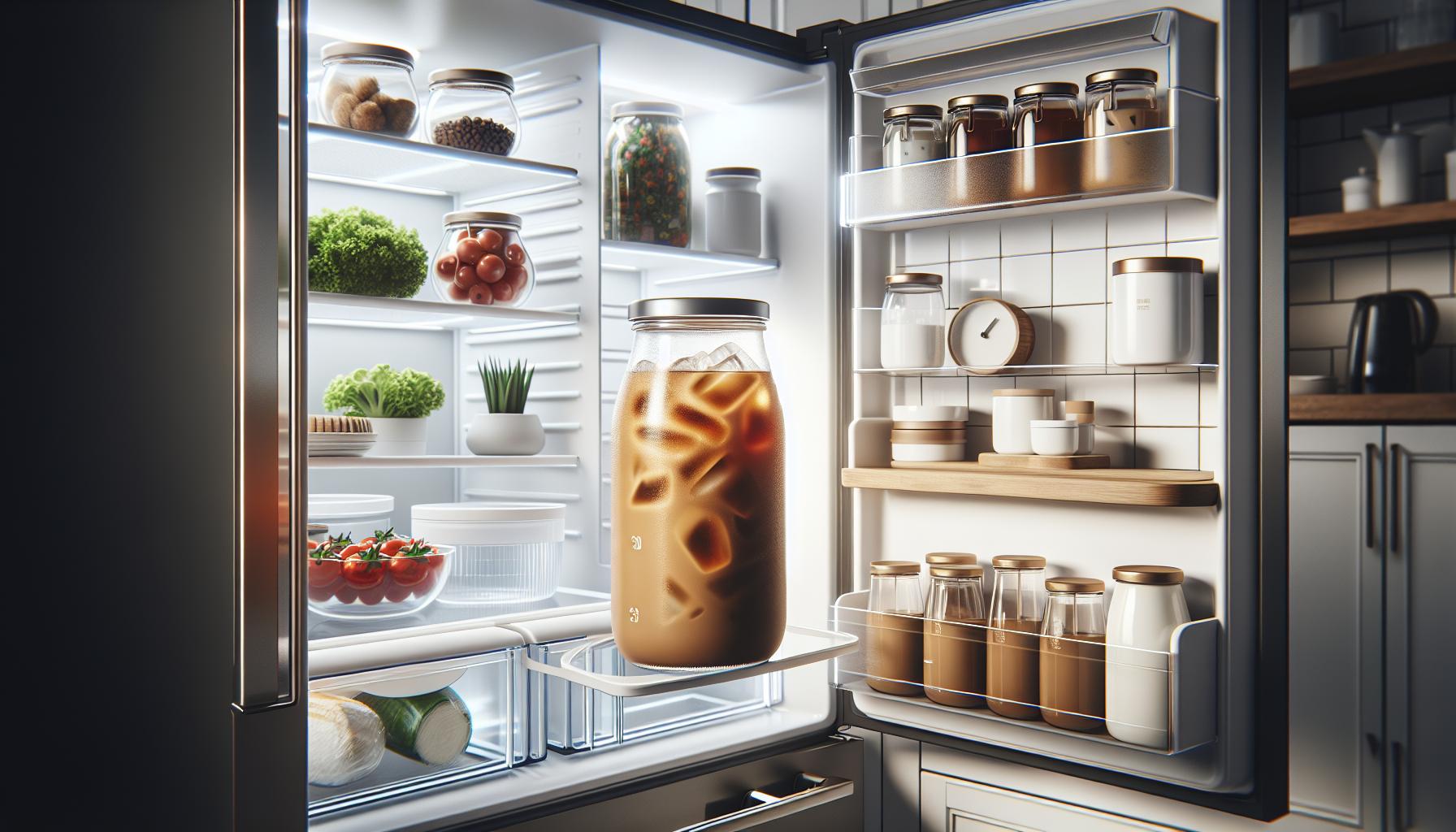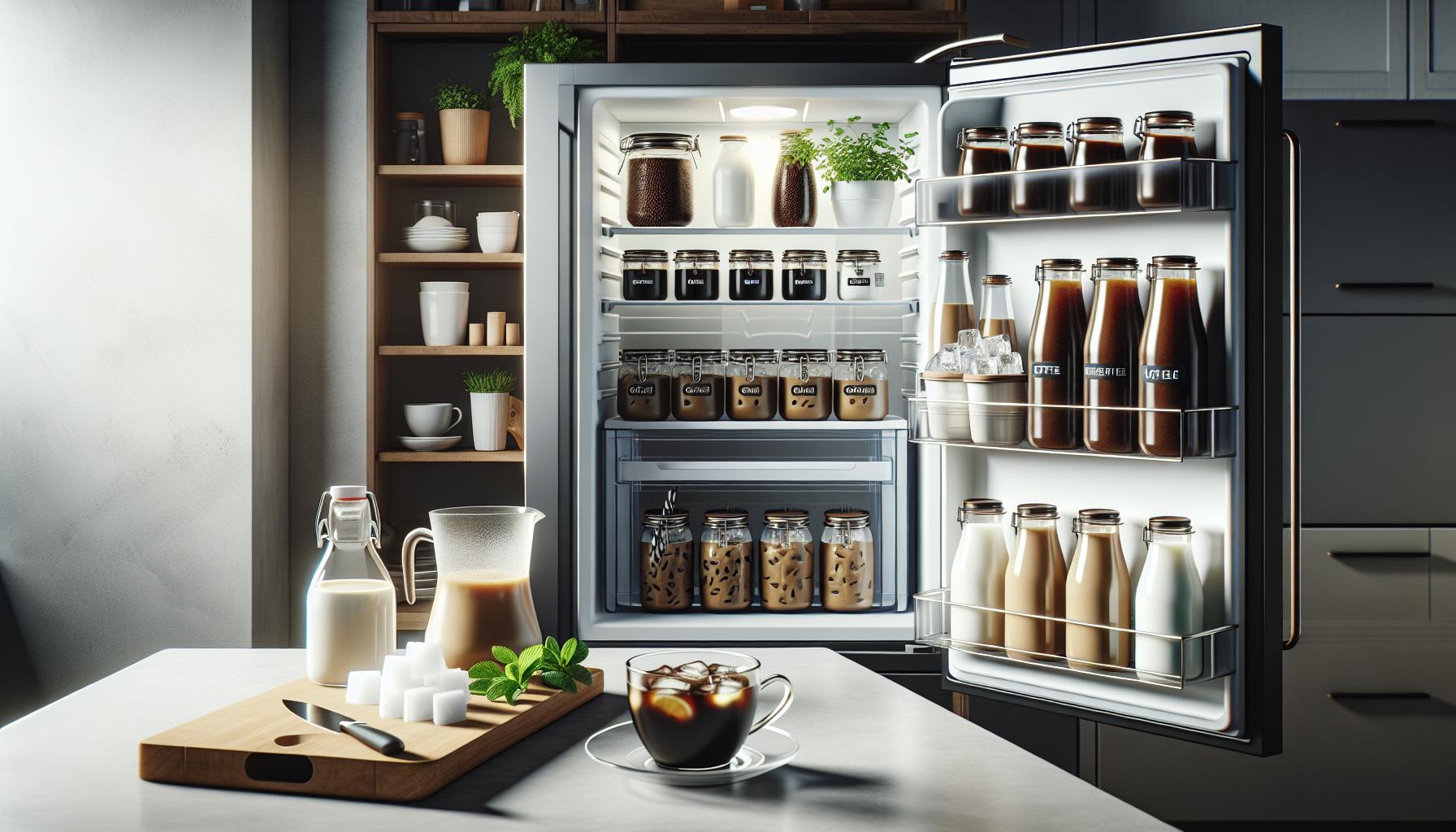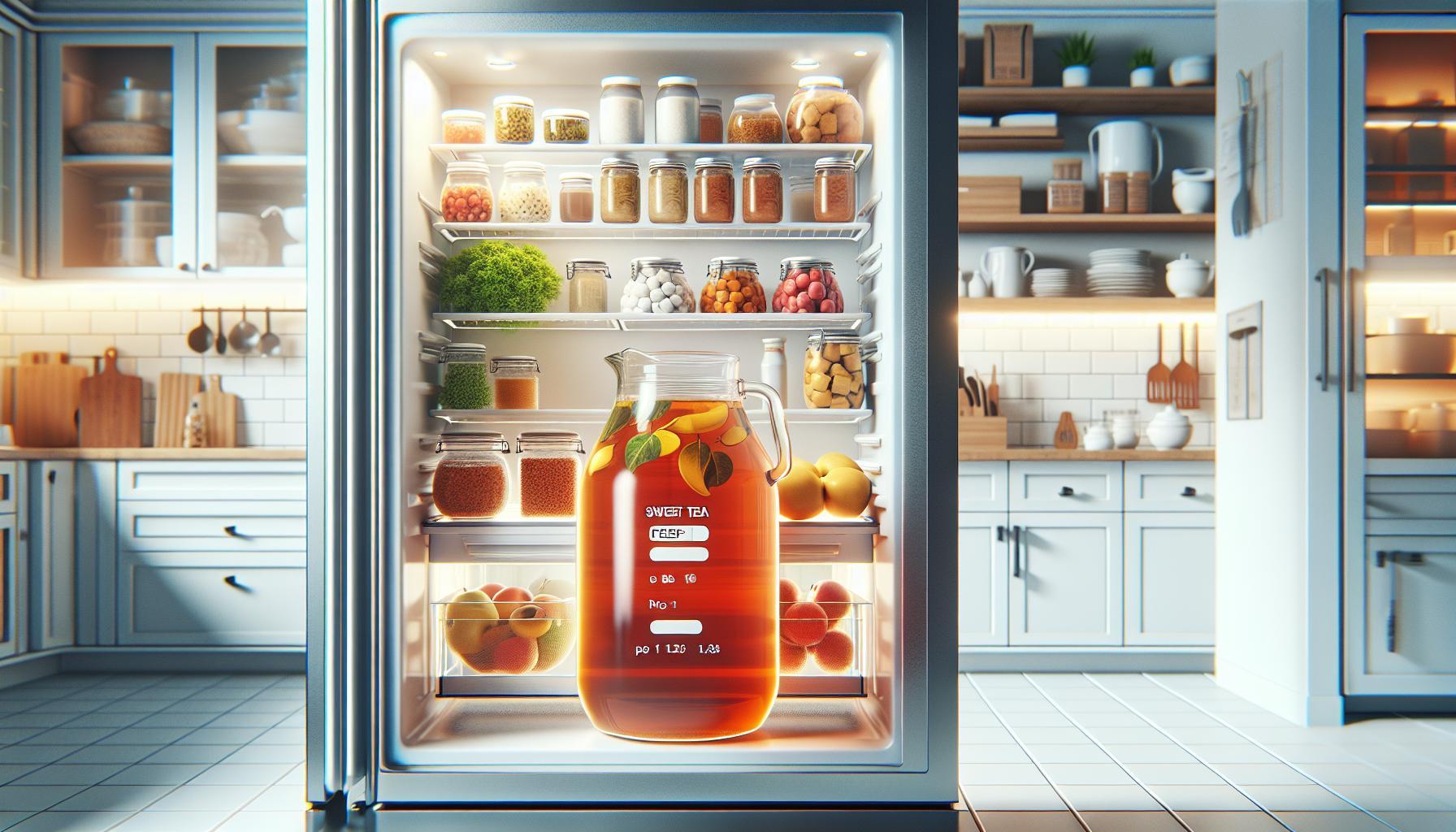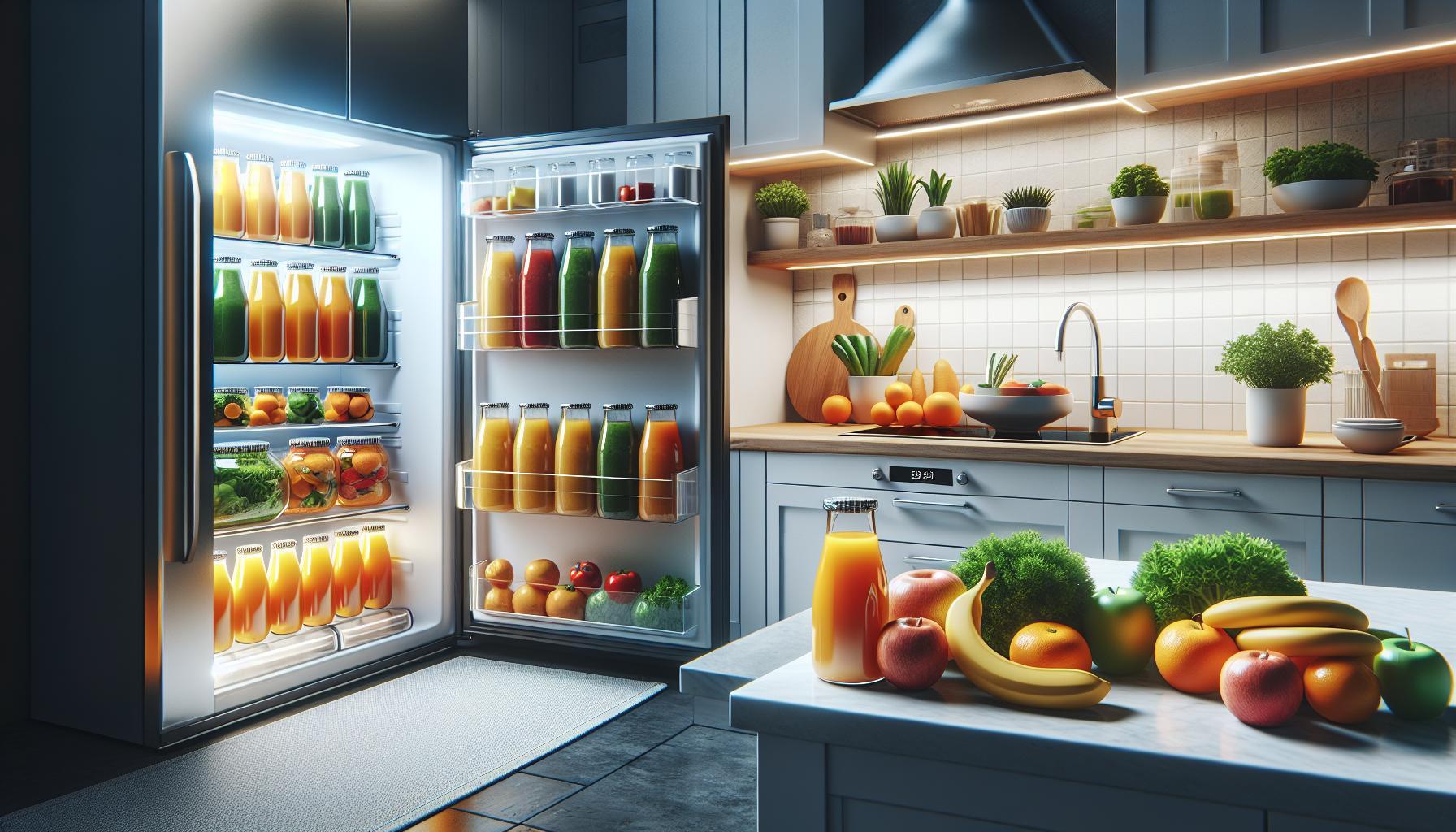Did you know that iced coffee can be a refreshing treat even days after it’s brewed? However, many are left wondering how long their cold brew can safely last in the fridge. Understanding the shelf life of iced coffee is key to enjoying your favorite drink without worry.
Storing iced coffee properly not only enhances its flavor but also ensures it remains safe to consume. Whether you’re a busy professional needing a quick caffeine fix or a leisurely sipper relishing every drop, knowing the best practices for storing iced coffee can elevate your coffee experience.
In this article, we’ll dive into the optimal storage time for your iced coffee, share useful tips, and provide guidance to help you enjoy every sip longer. Let’s unlock the secrets to preserving your cold brew goodness!
How Long Can Iced Coffee Last in the Fridge?

Iced coffee is a beloved beverage for many, providing a refreshing boost anytime. However, you may wonder how long it can safely last in your fridge without losing its delicious flavor or, more importantly, becoming unsafe to drink. Generally, homemade iced coffee can last about 3 to 7 days in the refrigerator, depending on several factors, including ingredients and storage methods.
To ensure your iced coffee remains fresh for as long as possible, consider the composition of your brew. Black coffee without any added milk or cream will typically last longer than iced coffee with dairy or sweeteners, which can spoil more quickly. If you’ve added milk or cream, it’s best to consume your iced coffee within 2 to 3 days. Always store it in an airtight container to minimize exposure to air, which can degrade the flavor.
The temperature of your fridge also plays a significant role in preserving the quality of iced coffee. It’s crucial to keep your fridge at or below 40°F (4°C). This temperature slows microbial growth, which can spoil your coffee prematurely. If you notice any off smells, changes in color, or separation after a few days, it’s best to discard the coffee to ensure your safety. Taking these precautions will allow you to enjoy your iced coffee over multiple days while savoring every chilled sip.
Factors Affecting Iced Coffee Freshness
When it comes to the freshness of iced coffee, several factors play a crucial role in determining how long this delightful beverage can be safely enjoyed. Understanding these elements not only enhances your drinking experience but also ensures that each sip is as flavorful and safe as the first.
One of the primary factors influencing iced coffee’s longevity is its composition. Iced coffee made purely from brewed coffee will generally last longer than those with added ingredients like milk, cream, or sweeteners. For instance, a black iced coffee can remain fresh for about 3 to 7 days, while iced coffee containing dairy should ideally be consumed within 2 to 3 days. The presence of these perishable ingredients increases the risk of spoilage, as they may create a suitable environment for bacteria to thrive.
Another important aspect is storage conditions. Keeping iced coffee in an airtight container not only protects it from contamination but also minimizes exposure to air, which can lead to oxidation and a decline in flavor. It’s also vital to maintain a refrigerator temperature below 40°F (4°C). This temperature effectively inhibits the growth of spoilage-causing microbes, contributing to the iced coffee’s freshness.
Lastly, the brewing method and quality of the coffee itself can affect freshness. Using fresh, high-quality beans and brewing methods that maximize flavor extraction can create a more robust iced coffee that retains its taste longer, regardless of the storage time. By being mindful of these factors-composition, storage, and brewing quality-you can enjoy your iced coffee to the fullest while ensuring it stays fresh and delicious.
Best Storage Practices for Iced Coffee

To maximize the freshness and flavor of your iced coffee while ensuring safety, proper storage practices are essential. It may surprise you, but how you store your iced coffee can either extend its shelf life or lead to quick spoilage. The key lies in controlling exposure to air, light, and temperature, all of which can degrade the quality of your beverage.
Start by choosing the right container for storage. An airtight, glass container is an excellent choice as it significantly reduces oxidation, keeping your iced coffee fresher for longer. Avoid plastic containers, which can retain odor and may not provide the same level of protection against air and light. When storing your iced coffee, fill the container as much as possible to minimize the amount of air trapped inside. This helps maintain the flavor and aroma, which can be compromised by oxidation.
Once your iced coffee is securely stored, place it in the back of your refrigerator, where temperatures are the most consistent and coldest. Ensure that your fridge is set to below 40°F (4°C) to inhibit bacterial growth. If you’ve added dairy or any perishable ingredients, plan to consume your iced coffee within 2 to 3 days for optimal freshness. On the other hand, black iced coffee can last longer-up to 3 to 7 days-depending on how it was brewed and stored.
Finally, always label your containers with the date when you made the iced coffee. This simple step will help you keep track of its freshness and decide when it’s the right time to enjoy it. Remember, adopting these best storage practices not only benefits the taste of your iced coffee but also ensures your safety as you enjoy this refreshing drink.
Signs Your Iced Coffee Has Gone Bad
Iced coffee, while a refreshing indulgence, has a limited lifespan, and knowing when it has gone bad is crucial for both flavor and safety. When stored properly in the fridge, black iced coffee typically lasts between 3 to 7 days, but several signs can indicate spoilage.
First, take note of any unpleasant odors. Fresh iced coffee should emit a rich, inviting aroma, but if it has developed an off-putting smell, it’s time to discard it. Additionally, visual cues are important; look for any changes in color. Iced coffee may darken or become cloudy, a sign that microbial growth is occurring. If you observe any sediment or floating particles, it’s safer to chuck it out.
Taste, while an essential gauge in determining freshness, should be approached cautiously-if the coffee tastes sour, stale, or otherwise unpleasant, it has likely passed its prime. If your iced coffee has been blended with dairy or sweeteners, these additions may spoil faster than the coffee itself. Thus, consume these mixtures within 2 to 3 days for the best results.
Maintaining awareness of these signs will enhance your iced coffee experience and ensure that each sip remains enjoyable. When in doubt, always prioritize safety over taste; if you’re uncertain about its freshness, it’s best to err on the side of caution and discard it.
How to Enjoy Iced Coffee Safely
To fully appreciate the enjoyable experience of sipping iced coffee, it’s essential to prioritize safety alongside flavor. The proper handling and storage of iced coffee can make a significant difference in how long you can enjoy this refreshing beverage without compromising your health. Iced coffee, if not stored correctly, can quickly become a breeding ground for bacteria and other pathogens, making it crucial to follow sound practices.
When preparing iced coffee, one critical step is to ensure that you cool the coffee rapidly after brewing. Allowing it to sit at room temperature for too long can facilitate bacterial growth. Aim to refrigerate your brewed coffee within two hours to minimize any risk. Once in the fridge, proper storage is vital; use an airtight container to reduce exposure to air, which can lead to oxidization and flavor degradation. Remember to label the container with the date brewed; doing so can serve as an easy reference for freshness, and a guideline for consumption periods.
Always remain vigilant for signs that your iced coffee may have gone bad. Unpleasant odors or a cloudy appearance can be red flags. If you notice any unusual textures or sediment, it’s best to err on the side of caution. For those who enjoy adding dairy or sweeteners, be aware that these additions can spoil much faster than black coffee. Aim to consume iced coffee made with these ingredients within 2 to 3 days for optimal safety and enjoyment. By adhering to these practices, you can ensure that every sip of your iced coffee is not only enjoyable but also safe.
Different Types of Iced Coffee and Their Longevity
Different types of iced coffee can have varying longevity depending on their ingredients and preparation methods. Understanding these differences is essential for maximizing freshness and maintaining flavor. Generally, black iced coffee has a longer shelf life compared to versions that include milk, cream, or flavored syrups. When stored properly in an airtight container in the refrigerator, plain black iced coffee can last up to 7 days. However, be prepared for subtle changes in flavor over time as the coffee may oxidize and lose some of its freshness.
In contrast, iced coffee that incorporates dairy or sweeteners should be consumed much sooner. Iced lattes or iced coffees with cream typically have a freshness window of 2 to 3 days. This shorter lifespan is mainly due to the perishable nature of milk and cream, which can spoil rapidly. To ensure quality, always use fresh dairy products, and consider making smaller batches so you can enjoy your iced coffees at their peak.
For those who love creative variations, consider the longevity of flavored iced coffees, such as mocha or caramel infusions. These beverages, which often include syrups or sauces, also tend to be less durable than plain black coffee. Aim to consume these drinks within 3 to 4 days, as the added sugars and flavors can impact preservation and safety. A valuable tip is to store flavored coffee in smaller containers, which minimizes the exposure to air every time you open the jar.
In summary, keeping track of the ingredients and storage methods can greatly influence the lifespan of your iced coffee. Here’s a quick reference guide for different types:
| Type of Iced Coffee | Longevity in Fridge |
|---|---|
| Black Iced Coffee | Up to 7 days |
| Iced Coffee with Dairy | 2 to 3 days |
| Flavored Iced Coffee | 3 to 4 days |
By being aware of these distinctions, you can ensure that each cup of iced coffee remains enjoyable and safe to consume, allowing you to savor every refreshing sip.
Creative Ways to Use Leftover Iced Coffee
Leftover iced coffee doesn’t have to go to waste; there are plenty of creative ways to upcycle it into delicious treats and drinks. First, consider transforming your cold brew into a refreshing coffee granita. Simply pour the iced coffee into a shallow container and freeze it. Every hour or so, use a fork to scrape and fluff the mixture until it achieves a grainy texture. This frozen delight can be enjoyed as a slushy dessert or even as a unique coffee topping for desserts like ice cream.
A Flavorful Finish: Iced Coffee Ice Cubes
Another innovative option is to make iced coffee ice cubes. Pour leftover iced coffee into an ice cube tray and freeze. These coffee cubes can be used to chill other beverages without diluting their flavor. For instance, drop a few coffee ice cubes into a glass of milk or a milk alternative for an easy iced coffee treat. You can also blend these cubes with milk, chocolate syrup, or vanilla extract for a speedy homemade frappé that’s both tasty and refreshing.
Elevate Breakfast with Coffee Creations
Leftover iced coffee can also find its way into your breakfast routine. Use it to make a delicious coffee-flavored smoothie by blending it with ripe bananas, a scoop of yogurt, and a touch of honey or a sweetener of your choice. This simple addition not only provides caffeine but also enriches your smoothie with a rich, robust flavor. Alternatively, consider using iced coffee in pancake or waffle batter for a breakfast treat with a twist-adding rich taste while still staving off food waste.
Ultimately, being creative with your iced coffee not only enhances your culinary repertoire but also maximizes the enjoyment of your favorite brew. Just remember to monitor the freshness guidelines: black iced coffee can generally last up to 7 days, while iced coffee with dairy has a shorter lifespan of 2 to 3 days. Following these tips ensures you safely utilize your iced coffee while indulging in delightful new recipes.
Tips for Reheating Iced Coffee Without Losing Flavor
Reheating iced coffee while preserving its rich flavor can be an art, but with a few smart techniques, you can enjoy your brew even when it’s no longer cold. Start by transferring your iced coffee from the fridge into a small saucepan if you want to warm it on the stove. Heat it gently over low to medium heat, stirring frequently to maintain an even temperature. A gradual warming process helps to retain the flavors and ensures you don’t accidentally scald the coffee, which can lead to bitterness.
If you prefer a quicker method, using a microwave is also a viable option. Pour your iced coffee into a microwave-safe container and heat it in short intervals, about 20-30 seconds, stirring in between. This approach helps prevent hotspots that could ruin the taste. Keep in mind, though, that while reheating coffee is possible, its quality may not be the same as when freshly brewed, especially if dairy was added.
For an added layer of deliciousness, consider incorporating some fresh ingredients after reheating. A splash of milk, a hint of vanilla extract, or even a spoonful of sweetener can enhance the flavor profile, making it feel like a new beverage. Enjoying your reheated iced coffee is all about balance; keep the temperature moderate, and feel free to experiment with flavors to find your perfect cup.
Lastly, be mindful of food safety; if your iced coffee has been in the fridge for more than 7 days (or 2-3 days if it contains dairy), it’s best to discard it to avoid the risk of spoilage. Following these guidelines will help you enjoy your iced coffee at its best, whether it’s heated or cold.
Flavoring Iced Coffee: Best Practices for Freshness
Enhancing your iced coffee with flavor can transform a simple drink into a refreshing and delightful experience. However, it’s essential to keep freshness and quality in mind as you add ingredients. To prolong the shelf life of your flavored iced coffee while maintaining its taste, consider the ingredients you choose and how they’re stored.
One of the best practices for flavoring iced coffee is to use fresh ingredients that can elevate the flavor without introducing elements that may spoil quickly. For example, natural flavorings like vanilla extract, unsweetened cocoa powder, or spices such as cinnamon can add depth without affecting the coffee’s longevity. Avoid the use of flavored syrups that contain high sugar content, as they can accelerate spoilage.
To ensure your iced coffee remains fresh after flavoring, it’s beneficial to keep it refrigerated in an airtight container. This method reduces exposure to air and light, both of which can degrade flavor and freshness over time. Additionally, if you’ve added dairy or plant-based creamers, be cautious with storage: dairy can spoil quickly, usually lasting about 2-3 days, while non-dairy options may have a longer shelf life depending on the ingredients.
When flavoring your iced coffee for long-term enjoyment, try to add perishable ingredients, such as milk or cream, just before serving rather than during storage. This approach helps maintain the integrity of the coffee itself while allowing for a custom flavor experience at the moment of consumption. Always remember to taste your iced coffee before serving it after it’s been stored-the freshness and flavor can change after a few days, so trust your senses.
In summary, choosing the right flavorings and storing your iced coffee properly are crucial for enjoying every sip for longer. Use fresh, stable ingredients and keep everything securely stored in the fridge. By adopting these practices, you can ensure that your iced coffee remains a delicious treat throughout the week.
When to Toss Iced Coffee: Safety Guidelines
When it comes to enjoying iced coffee, ensuring its safety is as important as its flavor. As a general rule, brewed iced coffee can last in the refrigerator for about 3 to 7 days, depending on the ingredients and how it was stored. However, the potential for spoilage increases significantly with the addition of dairy products or flavored syrups. If your iced coffee includes milk, cream, or any perishable ingredients, it’s safest to consume it within 2 to 3 days to prevent any risk of foodborne illness.
To determine when it’s time to toss out your iced coffee, consider a few clear indicators. If the coffee exhibits any off-putting odor, a change in color, or an unusual texture, these are strong signs it has turned. Additionally, if it tastes sour or otherwise different than when it was freshly made, it’s best to err on the side of caution and dispose of it. Always trust your senses-if something seems off, it probably is.
Proper storage can prolong the life of your iced coffee. Utilizing a clean, airtight container and keeping it at a consistent refrigerator temperature can help maintain its quality. If you’re uncertain about its safety after a few days, it’s better to discard it than risk consuming something that could make you ill. Always prioritize safe food handling practices and, when in doubt, choose freshness over wastefulness. By following these guidelines, you can enjoy your iced coffee safely, ensuring every sip remains delicious and risk-free.
The Science Behind Iced Coffee Preservation
The preservation of iced coffee is an intriguing blend of chemistry and proper food safety practices. When brewed coffee is chilled, a myriad of factors influences how long it can remain fresh and flavorful. The primary culprits behind spoilage are bacteria and chemical reactions that occur over time. As coffee cools, the rate of oxidation increases, particularly when exposed to air. This process can lead to off-flavors, often described as stale or bitter, that diminish the quality of your beverage.
One of the most significant factors affecting iced coffee’s longevity is its ingredients. Black brewed coffee has a longer shelf life-typically 3 to 7 days-while adding milk, cream, or flavored syrups dramatically shortens its safe consumption period to just 2 to 3 days. Dairy products foster bacterial growth, making them a prime candidate for spoilage, which can lead to foodborne illnesses. Therefore, understanding the chemistry behind these reactions can guide you in making smarter decisions about how and when to enjoy your iced coffee.
To effectively extend the freshness of your iced coffee, proper storage techniques are essential. Always store it in a clean, airtight container in the refrigerator at a consistent temperature below 40°F (4°C). This minimizes exposure to air and reduces temperature fluctuations that can encourage spoilage. As a bonus tip, consider using dark-colored containers, as they limit light exposure, which can also affect the coffee’s flavor profile over time.
Finally, recognizing the signs of spoilage is crucial. Changes in scent, color, or texture are immediate red flags. A sour taste is a clear indicator that it’s time to discard the coffee. Safeguarding your health doesn’t just rely on storage methods; it involves staying vigilant about sensory cues to ensure that every sip of your iced coffee is as delightful as the first.
Q&A
Q: How can I tell if my iced coffee has gone bad?
A: You can tell iced coffee has gone bad if it has an off smell, sour taste, or visible mold. Additionally, if it appears cloudy and separates, it’s best to discard it. Regularly check your stored iced coffee for these signs to ensure freshness.
Q: What is the best way to store iced coffee in the fridge?
A: The best way to store iced coffee is in a clean, airtight container to prevent exposure to air and odors. Glass jars or vacuum-sealed containers work well. Avoid adding ice when storing, as it will dilute the coffee and alter its taste.
Q: Can I freeze iced coffee to extend its shelf life?
A: Yes, you can freeze iced coffee to extend its shelf life. Pour it into ice cube trays or freezer-safe containers. When ready to use, thaw it in the fridge overnight or blend with ice for a chilled drink. However, note that texture may change post-freezing.
Q: How long can I keep bottled iced coffee in the fridge after opening?
A: Once opened, bottled iced coffee can usually last 3 to 7 days in the fridge. Always check the expiry date and smell it before drinking to ensure it hasn’t spoiled. For the best taste, consume it within a few days of opening.
Q: Does homemade iced coffee last longer than store-bought?
A: Homemade iced coffee may not last longer than store-bought varieties due to the lack of preservatives. Typically, homemade iced coffee stays fresh for 3 to 5 days in the fridge. Monitor for signs of spoilage to ensure quality.
Q: How should I reheat iced coffee without losing flavor?
A: To reheat iced coffee without losing flavor, warm it gently on the stove or in the microwave on low. Avoid boiling, as it can alter the taste. If you prefer cold coffee, blending it with ice can refresh the flavor while maintaining chill.
Q: Can I mix flavored syrups or creamers into my iced coffee during storage?
A: It’s best to add flavored syrups or creamers to iced coffee just before serving rather than during storage. These additives can change the texture and freshness of the coffee, potentially leading to quicker spoilage. Always store coffee plain for longer life.
Q: What types of iced coffee last the longest?
A: Iced coffee made with cold brew typically lasts longer than regular brewed iced coffee, lasting up to two weeks in the fridge due to its lower acidity. Additionally, coffee stored without milk or cream generally stays fresher longer.
To Wrap It Up
Now that you know how long iced coffee lasts in the fridge, you can savor those refreshing sips for days without worry. Remember, keeping your iced coffee in an airtight container can optimize its freshness, and if you’re ever in doubt about its quality, trust your senses. Ensure to check out our guide on coffee storage tips and ways to enhance your iced coffee experience for more insights.
Don’t let your delicious brew go to waste-make the most of every sip! Dive into our other articles to master your coffee game and elevate your brewing skills. If you found this guide helpful, consider subscribing to our newsletter for the latest tips and trends. Join the discussion in the comments below-share your favorite iced coffee recipes or your storage hacks! Enjoy your iced coffee journey, and keep exploring the world of coffee.





